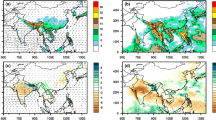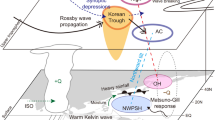Abstract
This study examines antecedent mid-tropospheric frontogenesis (AMF) resulting from the interaction between Typhoon Rusa (2002) and a midlatitude trough over the Korean Peninsula. In this event, the AMF contributed to the first peak in the time series of rainfall in Gangneung (37.75°N, 128.90°E), occurring about 12 h before the time of the extratropical transition (ET) process of the tropical cyclone (TC). Using observations and high-resolution model outputs, we showed that the AMF contributed to the antecedent rainfall in Gangneung during the first rainfall period when Gangneung was located outside of Rusa's sphere of direct influence. A Weather Research Forecasting (WRF) model experiment was conducted to diagnose the frontogenetical features and associated precipitation processes in detail. The experiment revealed that the AMF was mainly forced by the horizontal deformation forcing (HDF). The direction of the HDF was oriented from southwest to northeast in the middle part of the peninsula. The HDF increased positively due to the confluence of the southeasterlies from the TC and the northwesterlies emanating from the midlatitude trough. The experiment also suggested that the mid-tropospheric moisture originated from the subtropical ocean and deposited into the frontal region by the southerlies on the eastern periphery of the TC, which enhanced the convergence of moisture flux in the frontal region during the first rainfall period. The thermally direct circulation associated with the AMF lead to the mid-tropospheric saturation, which enhanced the precipitation of the first rainfall event together with the orographically forced convection at the low level above Gangneung.















Similar content being viewed by others
References
Anwender D, Harr PA, Jones SC (2008) Predictability associated with the downstream impacts of the extratropical transition of tropical cyclones: case studies. Mon Weather Rev 136:3226–3247
Baek EH, Kim JH, Kug JS, Lim GH (2013) Favorable versus unfavorable synoptic backgrounds for indirect precipitation events ahead of tropical cyclones approaching the Korean Peninsula: a comparison of two cases. Asia-Pacific J Atmos Sci. doi:10.1007/s13143-013-0031-0
Ballentine RJ (1980) A numerical investigation of New England coastal frontogenesis. Mon Weather Rev 108:1479–1497
Bluestein HB (1993) Synoptic-dynamic meteorology in midlatitudes: Vol. 2. Observations and theory of weather systems. Oxford Univ Press, New York, 253pp
Bosart LF, Carr FH (1978) A case study of excessive rainfall centered around Wellsville, New York, 20-21 June 1972. Mon Weather Rev 106:348–362
Bryan GH, Fritsch JM (2000) Diabatically driven discrete propagation of surface fronts: a numerical analysis. J Atmos Sci 57:2061–2079
Chen F, Dudia J (2001) Coupling an advanced land surface-hydrology model with the Penn State-NCAR MM5 modeling system. Part I: model implementation and sensitivity. Mon Weather Rev 129:569–585
Chen L, Li Y, Cheng Z (2010) An overview of research and forecasting on rainfall associated with landfalling tropical cyclones. Adv Atmos Sci 27(5):967–976
Doswell CA III, Brooks HE, Maddox RA (1996) Flash flood forecasting: an ingredients-based methodology. Weather Forecast 11:560–581
Dudhia J (1989) Numerical study of convection observed during the winter monsoon experiment using a mesoscale two-dimensional model. J Atmos Sci 46:3077–3107
Galarneau TJ Jr, Bosart LF, Schumacher RS (2010) Predecessor rain events ahead of tropical cyclones. Mon Weather Rev 138:3272–3297
Hanley D, Molinari J, Keyser D (2001) A composite study of the interaction between tropical cyclones and upper-tropospheric troughs. Mon Weather Rev 129:2570–2584
Harr PA, Elsberry RL (2000) Extratropical transition of tropical cyclones over the western North Pacific: Part I. Evolution of structural characteristics during the transition process. Mon Weather Rev 128:2613–2633
Harr PA, Elsberry RL, Hogan TF (2000) Extratropical transition of tropical cyclones over the western North Pacific: Part II. The impact of midlatitude circulation characteristics. Mon Weather Rev 128:2634–2653
Harr PA, Anwender D, Jones SC (2008) Predictability associated with the downstream impacts of the extratropical transition of tropical cyclones: methodology and a case study of Typhoon Nabi. Mon Weather Rev 136:3205–3225
Hong SY, Lim JO (2006) The WRF single-moment 6-class microphysics scheme (WSM6). J Korean Meteorol Soc 42:129–151
Hong SY, Dudhia J, Chen SH (2004) A revised approach to ice microphysical processer for the bulk parameterization of clouds and precipitation. Mon Weather Rev 132:103–120
Hong SY, Noh Y, Dudhia J (2006) A new vertical diffusion package with an explicit treatment of entrainment processes. Mon Weather Rev 134:2318–2341
Huffman GJ, Adler RF, Bolvin DT, Gu G, Nelkin EJ, Bowman KP, Hong Y, Stocker EF, Wolff DB (2007) The TRMM multi-satellite precipitation analysis: quasi-global, multi-year, combined-sensor precipitation estimates at fine scale. J Hydrometeorol 8:38–55
Jones SC, Harr PA, Abraham J, Bosart LF, Bowyer PJ, Evans JL, Hanely DE, Hanstrum BN, Hart RE, Lalaurette F, Sinclair MR, Smith RK, Thormcroft C (2003) The extratropical transition of tropical cyclones: forecast challenges, current understanding, and future directions. Weather Forecast 18:1052–1092
Kain JS, Fritsch JM (1990) A one-dimensional entraining/detraining plume model and its application in convective parameterization. J Atmos Sci 47:2748–2802
Kain JS, Fritsch JM (1993) Convective parameterization for mesoscale models: the Kain-Fritcsh scheme. In: Emanuel KA, Raymond DJ (eds) The representation of cumulus convection in numerical models. Am Meteorol Soc, 246 pp
Keyser D, Reeder MJ, Reed RJ (1988) A generalization of Petterssen's frontogenesis function and its relation to the forcing of vertical motion. Mon Weather Rev 116:762–780
Klein PM, Harr PA, Elsberry RL (2000) Extratropical transition of western North Pacific tropical cyclones: an overview and conceptual model of the transformation stage. Weather Forecast 15:373–395
Koch SE, McQueen JT, Karyampudi VM (1995) A numerical study of the effects of differential cloud cover on cold frontal structure and dynamics. J Atmos Sci 52:937–964
Lee DK, Choi SJ (2010) Observation and numerical prediction of torrential rainfall over Korea caused by Typhoon Rusa (2002). J Geophys Res 115, D12105
Locatelli JD, Stoelinga MT, Hobbs PV (2002) Organization and structure of clouds and precipitation on the mid-Atlantic coast of the United States. Part VII: diagnosis of a nonconvective rainband associated with a cold front aloft. Mon Weather Rev 130:278–297
Mlawer EJ, Taubman SJ, Brown PD, Iacono MJ, Clough SA (1997) Radiative transfer for inhomogeneous atmosphere: RRTM, a validated correlated-k model for the longwave. J Geophys Res 102:16663–16682
Novak DR, Bosart LF, Keyser D, Waldstreicher JS (2004) An observational study of cold season-Banded precipitation in Northeast U.S. Cyclones. Weather Forecast 19:993–1010
Orlanski I, Ross B, Polinsky L, Shaginaw R (1985) Advances in the theory of atmospheric fronts. Advances in Geophysics. vol 28, Part B. Academic, pp 223–252
Park SK, Lee E (2007) Synopitc features of orographically enhanced heavy rainfall on the east coast of Korea associated with Typhoon Rusa (2002). Geophys Res Lett 34, L02803. doi:10.1029/2006GL028592
Ritchie EA, Elsberry RL (2003) Simulations of the extratropical transition of tropical cyclones: contributions by the midlatitude upper-level trough to reintensification. Mon Weather Rev 131:2112–2128
Ritchie EA, Elsberry RL (2007) Simulations of the extratropical transition of tropical cyclones: phasing between the upper-level trough and tropical cyclones. Mon Weather Rev 135:862–876
Schultz DM, Doswell CA III (1999) Conceptual models of upper-level frontogenesis in southwesterly and northwesterly flow. Q J R Meteorol Soc 125:2535–2562
Schumacher RS, Galarneau TJ Jr, Bosart LF (2011) Distant effects of a recurving tropical cyclone on rainfall in a midlatitude convective system: a high-impact predecessor rain event. Mon Weather Rev 139:650–667
Sinclair MR (2002) Extratropical transition of southwest Pacific tropical cyclones: Part I. Climatology and mean structure changes. Mon Weather Rev 130:590–609
Skamarock WC, Coauthors (2008) A description of the advanced research WRF, version 3. NCAR Tech Note NCAR/TN 4751STR, 113 pp
Srock AF, Bosart LF (2009) Heavy precipitation associated with southern Appalachian cold-air damming and Carolina coastal frontogenesis in advance of weak landfalling Tropical Storm Marco (1990). Mon Weather Rev 137:2448–2470
Stohl A, Forster C, Sodemann H (2008) Remote sources of water vapor forming precipitation on the Norwegian west coast at 60°N—a tale of hurricanes and an atmospheric river. J Geophys Res 113, D05102. doi:10.1029/2007JD009006
Wang Y, Wang Y, Fudeyasu H (2009) The role of Typhoon Songda (2004) in producing distantly located heavy rainfall in Japan. Mon Weather Rev 137:3699–3716
Acknowledgments
This research was funded by the Korea meteorological Administration Research and Development Program under Grant Cater 2012-3062. JSK was supported by the National Research Foundation of Korea (Grant NRF-2009-C1AAA001-2009-0093042) funded by the Korean government (MEST). The modeling integration was supported by grant KSC-2012-C2-25 from Korea Institute of Science and Technology Information.
Author information
Authors and Affiliations
Corresponding authors
Appendix 1
Appendix 1
Sedimentation of hydrometeor contents (SHC)
The vertically integrated water vapor and total hydrometeor contents budgets can be expressed as:
where a term in square brackets signifies a mass-weighted vertical integration between two levels (p 1 and p 2) as defined by \( \left[F\right]=\frac{1}{g}{\displaystyle \underset{p_1}{\overset{p_2}{\int }}}F\mathrm{d}p \) for any variable F. In Eqs. A1 and A2, q v is the mixing ratio of water vapor and C is the sum of mixing ratios of hydrometeor contents; that is, cloud water, rain water, cloud ice, snow, and graupel, (ADVqv), and (ADVC) are three-dimensional advection of water vapor and hydrometeor contents, respectively. S qv and S c are the source and sink in the water vapor and hydrometeor contents budget due to conversions between water vapor and various hydrometeor species. SHC is total sedimentation of hydrometeor contents, i.e., \( \mathrm{SHC}=\frac{1}{g}\frac{\partial }{\partial p}\left({q}_{\mathrm{C}}{\upomega}_{\mathrm{T}}\right) \), where q C and ωT are mixing ratio of hydrometeor contents and terminal velocity, due to saturation in specific column. Note that (S qv) = (S c), when averaged over the specific region. Then (SHC) is expressed as:
which means that SHC indicates the fallout residual following an air parcel. Equation A3 presents the difference between precipitation and evaporation at the surface if the SHC is integrated from the surface to the top of the model:
where P s, E s, p s, and p t denote precipitation, evaporation, surface pressure, and the pressure at the top of the model, respectively.
Rights and permissions
About this article
Cite this article
Baek, EH., Lim, GH., Kim, JH. et al. Antecedent mid-tropospheric frontogenesis caused by the interaction between a tropical cyclone and midlatitude trough: a case study of Typhoon Rusa (2002). Theor Appl Climatol 118, 9–24 (2014). https://doi.org/10.1007/s00704-013-1045-3
Received:
Accepted:
Published:
Issue Date:
DOI: https://doi.org/10.1007/s00704-013-1045-3




